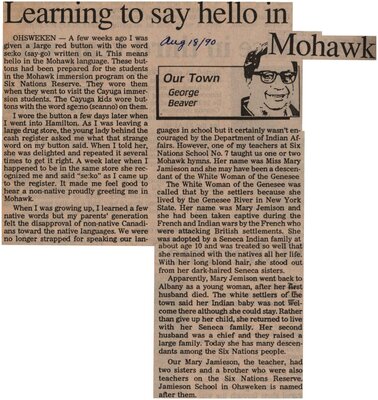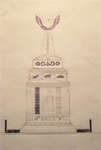Learning To Say Hello in Mohawk"
- Publication
- Brantford Expositor, Summer 1990
- Full Text
- Learning to say hello in Mohawk
OHSWEKEN - A few weeks ago I was given a large red button with the word se:ko (say-go) written on it. This means hello in the Mohawk language. These buttons had been prepared for the students In the Mohawk immersion program on the Six Nations Reserve. They wore them when they went to visit the Cayuga immersion students. The Cayuga kids wore buttons with the word sge:no (scanno) on them.
I wore the button a few days later when I went into Hamilton. As I was leaving a large drug store, the young lady behind the cash register asked me what that strange word on my button said. When I told her, she was delighted and repeated it several times to get it right. A week later when I happened to be in the same store she recognized me and said "se:ko" as I came up to the register. It made me feel good to hear a non-native proudly greeting me in Mohawk.
When I was growing up, I learned a few native words but my parents' generation felt the disapproval of non-native Canadians toward the native languages. We were no longer strapped for speaking our languages in school but it certainly wasn't encouraged by the Department of Indian Affairs. However, one of my teachers at Six Nations School No. 7 taught us one or two Mohawk hymns. Her name was Miss Mary Jamieson and she may have been a descendant of the White Woman of the Genesee.
The White Woman of the Genesee was called that by the settlers because she lived by the Genesee River in New York State. Her name was Mary Jemison and she had been taken captive during the French and Indian wars by the French who were attacking British settlements. She was adopted by a Seneca Indian family at about age 10 and she was treated so well that she remained with the natives all her life. With her long blond hair, she stood out from her dark-haired Seneca sisters.
Apparently, Mary Jemison went back to Albany as a young woman, after her first husband died. The white settlers of the town said her Indian baby was not welcome there although she could stay. Rather than give up her child, she returned to live with her Seneca family. Her second husband was a chief and they raised a large family. Today she has many descendants among the Six Nations people.
Our Mary Jamieson, the teacher, had two sisters and a brother who were also teachers on the Six Nations Reserve. Jamieson School in Ohsweken is named after them.
- Creator
- Beaver, George, Author
- Media Type
- Newspaper
- Item Types
- Articles
- Clippings
- Description
- "A few weeks ago I was given a large red button with the word se:ko (say-go) written on it. This means hello in the Mohawk language. These buttons had been prepared for the students in the Mohawk immersion program on the Six Nations Reserve. They wore them when they went to visit the Cayuga immersion students. The Cayuga kids wore buttons with the word sge:no (scanno) on them."
- Date of Original
- Summer 1990
- Subject(s)
- Personal Name(s)
- Jamieson, Mary.
- Corporate Name(s)
- Department of Indian Affairs ; Jamieson Elementary School
- Local identifier
- SNPL002478v00d
- Collection
- Scrapbook #2
- Language of Item
- English
- Geographic Coverage
-
-
Ontario, Canada
Latitude: 43.06681 Longitude: -80.11635
-
- Creative Commons licence
 [more details]
[more details]- Copyright Statement
- Public domain: Copyright has expired according to Canadian law. No restrictions on use.
- Copyright Date
- 1990
- Copyright Holder
- Brantford Expositor
- Contact
- Six Nations Public LibraryEmail:info@snpl.ca
Website:
Agency street/mail address:1679 Chiefswood Rd
PO Box 149
Ohsweken, ON N0A 1M0
519-445-2954



